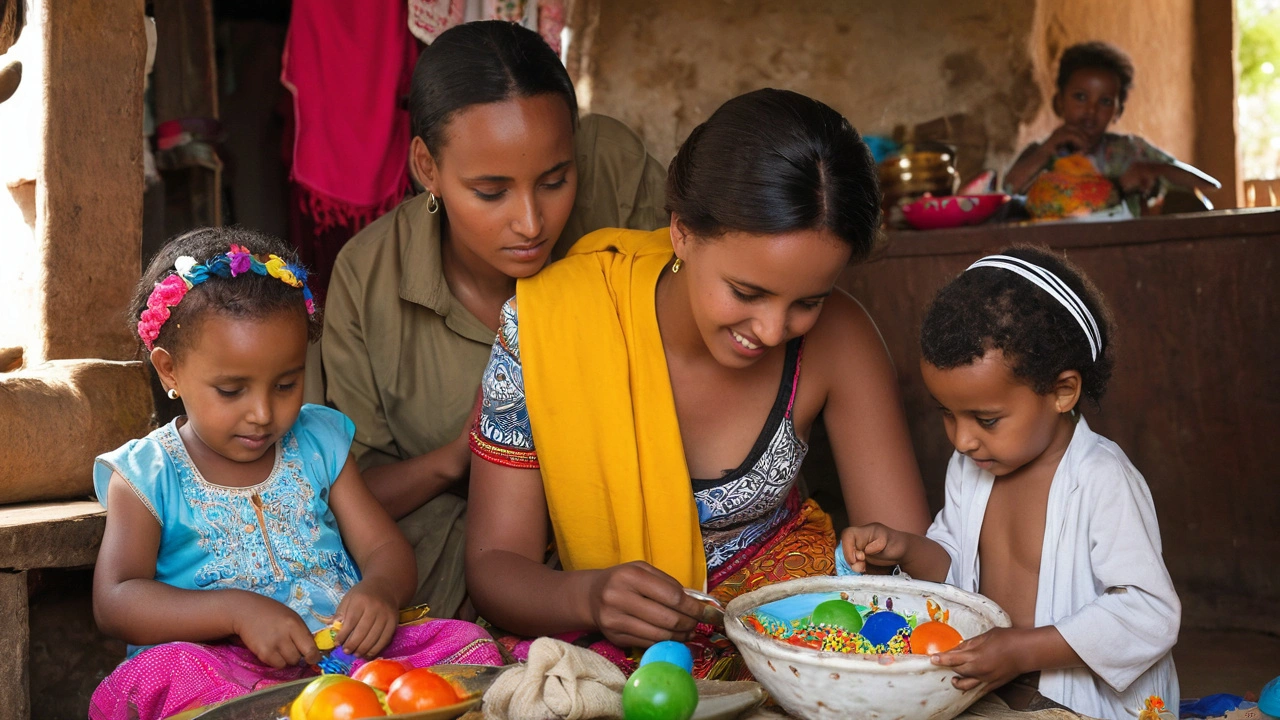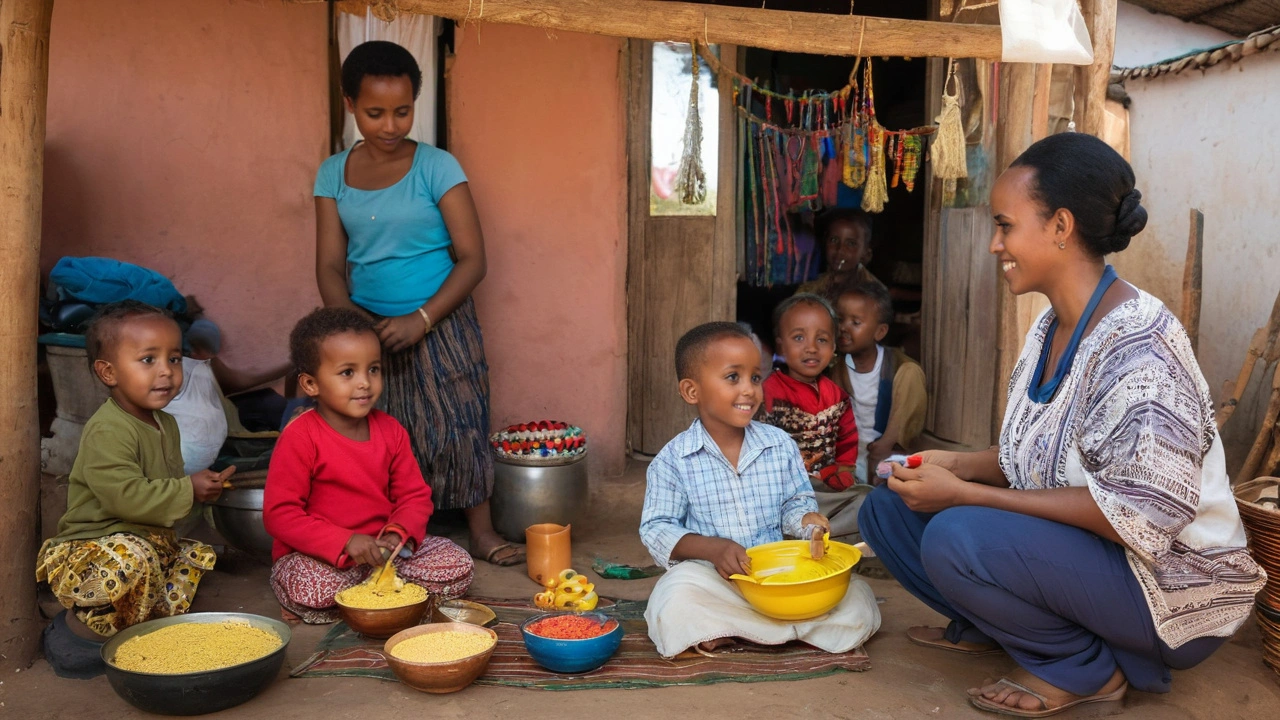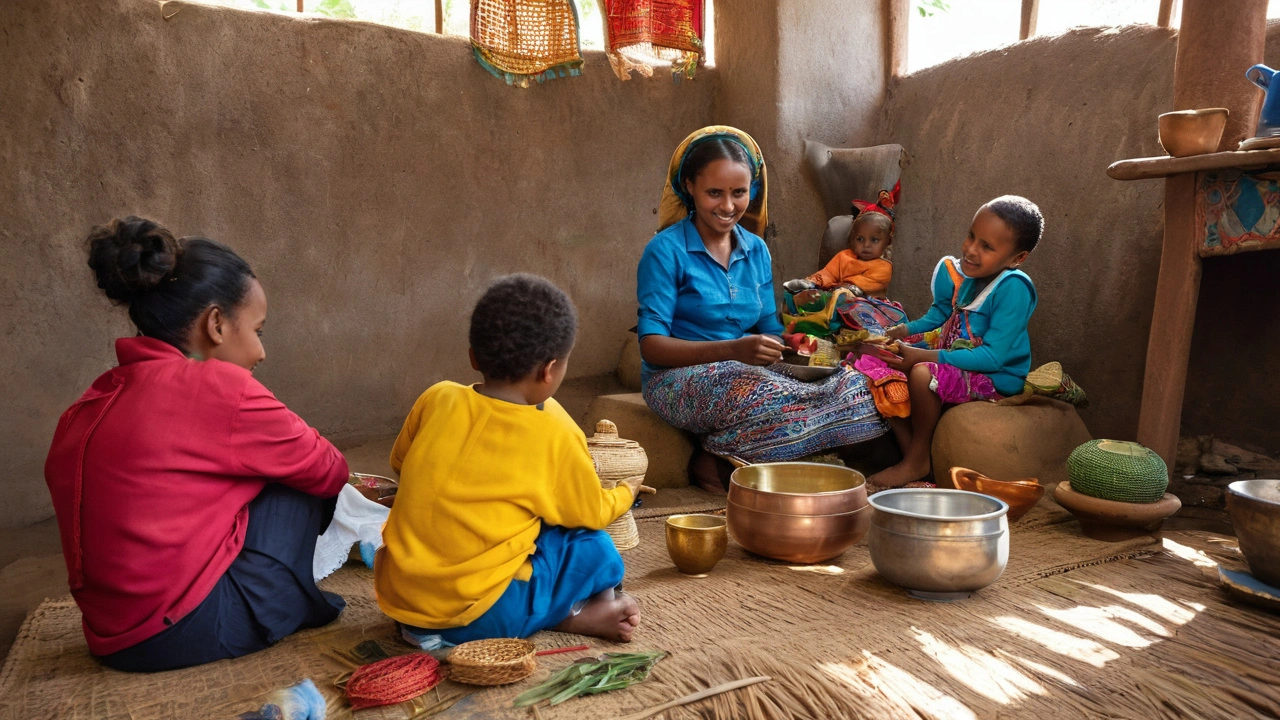Delving into the financial landscape of Ethiopia presents a unique view of a country balancing tradition and rapid change. When examining household income, it's vital to understand the broader economic context.
The Ethiopian economy has shown strong growth rates over recent years, but this hasn't always translated to higher wages for everyone. Income sources, including agriculture, government jobs, and the burgeoning tech sector, vary widely and influence household budgets.
Analyzing the average household income provides a glimpse into how Ethiopian families manage their daily expenses. It highlights the differences between urban and rural living, and reveals the underlying economic challenges. The cost of living, encompassing essentials like food, housing, and healthcare, is a critical part of this discussion.
Economic Overview
Stepping into the economic backdrop of Ethiopia is like diving into a vibrant and evolving narrative. The Ethiopian economy has often been described as one of the fastest-growing in Africa, and this transformation is evident in various facets of life.
First and foremost, agriculture remains the backbone of the country's economy. Over 70% of the population depends on farming, providing not just food but a livelihood. From coffee, which Ethiopia is famously known for, to teff, a staple grain for injera, agriculture weaves through the very fabric of society. However, this heavy reliance on agriculture comes with vulnerabilities, especially with shifting climate patterns.
On another front, the Ethiopian government has taken significant steps to diversify the economy. Investments in infrastructure, driven by state-led projects, have revitalized transportation networks and energy supply. The construction of the Grand Ethiopian Renaissance Dam is a testament to such ambition. This dam is expected to not only provide electricity domestically but also generate revenue through energy exports to neighboring countries.
Despite these strides, challenges persist. The service sector, particularly telecommunications and banking, has seen liberalization efforts. However, businesses still grapple with regulatory hurdles and bureaucratic red tape. Urbanization continues at a rapid pace, and cities like Addis Ababa are growing swiftly, attracting both local and foreign investments. The digital economy, bolstered by a rising tech-savvy younger population, presents a promising frontier.
The average Ethiopian's income cannot be fully understood without considering the broad spectrum of economic activities, including small-scale enterprises and informal jobs. Recent data suggests that while there has been progress, the economic gains are not uniformly distributed. Disparities between urban and rural areas remain stark. The wealth in cities contrasts sharply with the modest means in many rural communities.
The COVID-19 pandemic also brought about unexpected challenges. Like many countries, Ethiopia faced economic slowdowns, affecting employment and household incomes. Yet, resilience is a defining characteristic of the Ethiopian economy. According to Dr. Abiy Ahmed, the Prime Minister, in a 2023 address, "Our nation's strength lies in its ability to adapt and thrive, even in adversity."
"Economic reforms are essential to sustaining the growth momentum and ensuring the benefits reach every household," remarked the International Monetary Fund in a recent assessment.
As Ethiopia pushes forward, it's essential for both policy-makers and citizens to work collectively. Sustainable economic policies, along with grassroots efforts to uplift communities, are key to harnessing the full potential of this nation's economic landscape.

Factors Influencing Income
Ethiopian household incomes are influenced by a range of factors that paint a complex picture of financial health. One significant factor is the country’s economic structure, with agriculture remaining a primary income source for many. Despite the rapid growth in other sectors, nearly 70% of the population depends on farming. Rural areas, in particular, see a heavy reliance on agriculture, which is often subject to the whims of climate and market prices.
The urban-rural divide is another critical factor affecting income levels. Urban areas, including Addis Ababa, offer more diverse job opportunities in sectors such as government, education, and the burgeoning tech industry. These jobs tend to pay higher wages compared to rural areas, where employment options are limited and wages often lower. The migration of individuals from rural to urban settings in search of better-paying jobs is a common occurrence.
Education and skill level also play pivotal roles in income determination. Higher education levels generally correlate with better-paying jobs. In recent years, there’s been a noticeable push towards educational development in Ethiopia, with more universities and vocational training centers cropping up across the country. This shift is gradually transforming the workforce and potentially raising household incomes.
Government policies and economic reforms significantly impact household incomes as well. Over the last few years, the Ethiopian government has focused on various economic reforms aimed at increasing investment and job creation. Infrastructure projects, like the Grand Ethiopian Renaissance Dam, aim to boost the economy and create employment opportunities which directly affect household incomes.
The global economic climate cannot be ignored either. International trade relationships, foreign investments, and global market trends heavily influence the Ethiopian economy. Inflation, especially, poses a direct threat to purchasing power, thereby affecting what households can afford on their incomes.
"The average income in Ethiopia has seen changes due to significant economic policies and the diversification of sectors beyond agriculture," says Alemayehu Geda, Professor of Economics at Addis Ababa University, highlighting the ongoing economic transformation.
Inflation also plays a significant role in determining household income and purchasing power. As costs for goods rise disproportionately compared to wages, it directly impacts the spending capabilities of Ethiopian families. Daily essentials like food and transportation become more difficult to afford, especially for lower-income households.
Gender disparities continue to be a noteworthy factor. Men typically earn more than women, attributed to both social norms and employment types. Efforts to close this gap through gender-inclusive policies and educational opportunities for women are ongoing, but progress has been gradual.
Lastly, economic diversification remains a cornerstone of improved household income. The shift from a predominantly agrarian economy to one including manufacturing and services offers new employment choices and the potential for higher wages. This diversification is critical to balancing income levels across various regions and communities.

Average Household Income
When exploring the average household income in Ethiopia, we uncover a story that is as complex as it is revealing. Ethiopia's economy is growing at a substantial rate, yet this growth is not evenly distributed across the population. In urban areas, particularly in cities like Addis Ababa, there's more opportunity for higher income thanks to evolving industries and better access to education and resources. Here, the average household income can range from $150 to $600 per month.
However, in rural areas where agriculture is still the primary source of income, the figures are starkly different. A typical household in these regions might earn between $30 to $100 per month, largely depending on the success of their farming activities and market prices. These numbers shed light on the economic disparity between urban and rural Ethiopia, a divide that the government is striving to bridge through various development programs.
Furthermore, the average household income in Ethiopia is influenced by several factors, including level of education, access to healthcare, and employment opportunities. For instance, households with members who have higher education degrees or specialized skills tend to earn more. Jobs in technology, finance, and education sectors offer better salaries compared to those in unskilled labor markets.
This disparity in income is also reflected in the cost of living. Urban households often spend more on rent, utilities, and other services, which can be relatively high compared to their earnings. In contrast, rural households might have lower expenses, but their income levels make it challenging to afford basic needs. According to a World Bank report, as of 2023, the average per capita income in Ethiopia was estimated at $960 annually, highlighting the ongoing challenges in improving livelihoods across the country.
Dr. Kebede, an economist at Addis Ababa University, notes,
"While there have been improvements in middle-income sectors, the gap between the higher and lower-income households remains significant. Bridging this gap requires strategic policies focused on education, healthcare, and infrastructural development."Earlier attempts by the government and international organizations have shown progress but have also underscored the need for sustainable and inclusive growth strategies.
In summary, understanding the average household income in Ethiopia requires more than just looking at the numbers. It involves considering the broader economic context, the stark differences between urban and rural incomes, and the underlying factors that influence these earnings. By addressing these disparities and fostering inclusive growth, Ethiopia can pave the way for a more equitable economic future.

Cost of Living
Understanding the cost of living in Ethiopia is essential for grasping how household incomes align with daily expenses. Compared to many countries, Ethiopia's cost of living is relatively low, but it can still pose significant challenges, especially in rural areas. Essentials such as food, housing, transportation, and healthcare form the basic components of these expenses. Bread prices, for instance, are much lower compared to Western countries, but staples like teff or coffee can be more expensive due to local demands and production costs.
Housing is a major factor in the Ethiopian cost of living. In urban centers like Addis Ababa, rent prices can be steep, particularly in modern apartments and central districts. Conversely, rural areas may have lower costs but often lack essential services and infrastructure. The price for a one-bedroom apartment in the city center can easily surpass 10,000 ETB (about 200 USD), while outside the city, it might drop to half of that.
Transportation costs vary depending on the mode of travel. Public transport, including minibuses and city buses, remains affordable for the majority of the population. However, owning a private vehicle can be costly due to high import taxes on cars and fuel prices. For many families, getting around the city can mean spending a few hundred ETB (around 10-15 USD) monthly, which is a significant portion of their income.
Healthcare is another critical area. Ethiopia's public healthcare system provides basic services, but many prefer private clinics for better quality care, despite the higher costs. A typical visit to a private clinic can range from 200 to 500 ETB (4-10 USD), and medications often come at an additional expense. For serious conditions, the costs can escalate rapidly, placing a heavy burden on household finances.
Food prices are influenced by both local and international factors. Ethiopia, being agrarian, produces a variety of crops, yet food inflation can drive up prices unpredictably. While locally grown fruits, vegetables, and grains are affordable, imported goods like dairy products and processed foods can be expensive. A monthly grocery bill for an average family of four might range from 3,000 to 7,000 ETB (60-140 USD), depending on their dietary preferences.
Education costs, although not a direct component of everyday living, significantly impact household budgets. Public schools are available but often poorly funded. As a result, many parents opt for private schools, where tuition fees can vary widely. A year’s tuition at a private school can cost anywhere from 15,000 to 50,000 ETB (300-1,000 USD), which is a hefty sum considering the average household income.
A World Bank report highlights, "Despite substantial growth in recent years, many Ethiopian families still find it difficult to cover their essential expenses due to inflation and slow wage growth."
Utilities such as electricity, water, and internet also add to living costs. Although electricity and water are relatively cheap, power outages and water shortages are common, often leading households to incur additional costs for generators or water delivery. An average family might spend around 1,000 ETB (20 USD) monthly on these utilities.
Overall, while the cost of living in Ethiopia can be manageable, it still presents various challenges. Many families juggle their expenses carefully to ensure they meet their basic needs. By understanding the nuances of these costs, one can grasp the everyday struggles and resilience of Ethiopian households.

 Understanding Average Income Levels in Ethiopia: Analysis in USD
Understanding Average Income Levels in Ethiopia: Analysis in USD
 Making Money on YouTube in Ethiopia: A Practical Guide
Making Money on YouTube in Ethiopia: A Practical Guide
 Understanding Ethiopia's Economic Challenges: Reasons Behind its Low Income Status
Understanding Ethiopia's Economic Challenges: Reasons Behind its Low Income Status
 Exploring Ethiopia's Economic Backbone: Top Exports Driving Growth
Exploring Ethiopia's Economic Backbone: Top Exports Driving Growth
 Is Ethiopia a Safe Place to Visit for Travelers in 2024?
Is Ethiopia a Safe Place to Visit for Travelers in 2024?
Kim Chase
August 11, 2024 AT 17:35Hey folks, great post!
I think the mix of agriculture and tech really shows how Ethiopia is evolving.
It's defiantly worth digging deeper into how rural famlies can benefit.
Keep the convo going!
David Werner
August 12, 2024 AT 07:28Wow, this sounds like a carefully crafted narrative to hide the real story.
The government's growth stats are probably a front for foreign interests pulling the strings behind the dam and the IMF's sweet talk.
We're being fed a fairy tale while the average family struggles in silence.
It's a classic case of elite puppetry!
Paul KEIL
August 12, 2024 AT 21:21The macroeconomic paradigm shift delineated herein underscores a systemic reallocation of capital assets from agrarian subsistence to high‑frequency tech verticals, catalyzing a polarity in income distribution.
Horace Wormely
August 13, 2024 AT 11:15The data presented aligns with World Bank figures, indicating a significant urban‑rural income gap.
christine mae cotejo
August 14, 2024 AT 01:08Reading through this comprehensive overview of Ethiopia's household income landscape feels like embarking on a long, winding journey across contrasting terrains.
On one hand, the bustling streets of Addis Ababa pulse with emerging tech startups, modern cafés, and a growing middle class that seems to chase aspirational lifestyles.
On the other hand, countless villages dot the highlands, where families still tend to teff fields under the scorching sun, their earnings tied to unpredictable rains.
The stark disparity between these worlds is not just a matter of numbers; it reflects historical patterns of land ownership, education access, and infrastructural development.
While the government touts impressive GDP growth, the average household in the capital can now afford a modest subscription to internet services, yet many rural households cannot even purchase a reliable bicycle.
Inflation, as the report notes, gnaws at purchasing power, turning a simple basket of staple foods into a luxury for many.
Moreover, gender disparities persist, with women in agricultural regions often receiving less than half the earnings of their male counterparts.
Education emerges as a beacon of hope, as youths who complete secondary school increasingly find opportunities in the service sector.
Nonetheless, the transition from agrarian to diversified economies is fraught with challenges, including limited access to credit and market information.
The Grand Ethiopian Renaissance Dam, while a marvel of engineering, also illustrates how large‑scale projects can displace communities and reshape local economies.
Healthcare costs, especially in private clinics, remain out of reach for many families, forcing them to choose between medicine and food.
Yet, resilience shines through; community cooperatives in many regions pool resources to buffer against crop failures.
International partners, through targeted development programs, have begun to address these gaps, but sustainable change requires local ownership.
In sum, the average household income figures are more than statistics; they tell a story of aspiration, adversity, and the relentless drive of ordinary Ethiopians.
If policymakers and citizens continue to collaborate, the path toward a more equitable economic future is within reach.
Douglas Gnesda
August 14, 2024 AT 15:01Appreciate the deep dive! Could you elaborate on how recent vocational training initiatives are impacting income levels in peripheral towns? The link between skill acquisition and wage growth would be interesting to explore.
Abhijit Pimpale
August 15, 2024 AT 04:55The per‑capita income figure merely masks the underlying variance; median household earnings provide a clearer picture.
Eric DE FONDAUMIERE
August 15, 2024 AT 18:48Great post! I thik it really shows how diversifiyng the economy can lift peopel out of poverty. Keep it up!
Pauline Herrin
August 16, 2024 AT 08:41While the article presents a laudable overview, it neglects to critically assess the fiscal sustainability of the infrastructure projects cited, particularly in relation to debt servicing obligations.
pradeep kumar
August 16, 2024 AT 22:35The analysis glosses over the fact that inflation rates have surged beyond the projected 5%, eroding real wages across all sectors.
love monster
August 17, 2024 AT 12:28Nice summary! For anyone looking to improve their financial literacy, consider tracking monthly expenses against the average cost‑of‑living benchmarks outlined here.
Christian Barthelt
August 18, 2024 AT 02:21Actually, the average household income range cited for urban areas appears understated; recent surveys suggest a lower bound closer to $800 per month.
Ify Okocha
August 18, 2024 AT 16:15This piece is riddled with optimistic bias and cherry‑picked data, ignoring the entrenched corruption that sabotages any real progress.
William Anderson
August 19, 2024 AT 06:08Oh, the tragedy! A nation rich in culture yet shackled by poverty-how dramatically the heavens weep for Ethiopia!
Sherri Gassaway
August 19, 2024 AT 20:01One might ponder whether the pursuit of higher income truly equates to an elevated existence, or if the collective well‑being of the community transcends material measure.